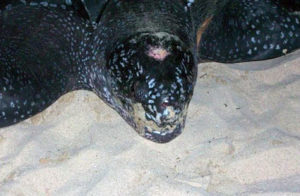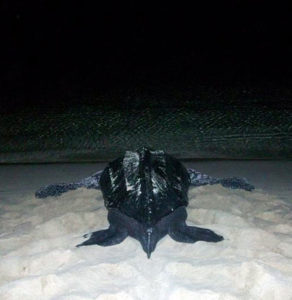Hello, Frank Indiviglio here. Please see Part I of this article for information on the care of freshwater shrimps, and for profiles of other popular species. Today I’ll highlight a few beautiful, lesser-known species in the genus Caridina and Brazil’s yellow-bellied grass shrimp.
Red-Nosed or Rhino Shrimp, Caridina gracilirostris

Rainbow Shrimp, Caridina babault
This ¾ inch beauty occupies a huge natural range – India through Malaysia – and occurs in an equally impressive range of colors – blue, red, rust, yellow and variations thereof.
Black Forest Shrimp, Caridina sp.
Dwelling in Thailand and perhaps elsewhere in Southeast Asia, this shrimp-fancier’s favorite is boldly marked with a broad white band about the body and a white-tipped head. At 1 inch in length, it is large enough to make quite an impressive display when kept in groups.
Brazilian Yellow-Bellied Grass Shrimp, Palaemon pantanal
 One of the few South American species in the trade, this hardy 1.5 inch long fellow is best kept in cooler waters than the aforementioned species, and is an excellent choice for an outdoor pond. It does best at temperatures of 68-70 F, but will remain active and healthy in colder conditions as well.
One of the few South American species in the trade, this hardy 1.5 inch long fellow is best kept in cooler waters than the aforementioned species, and is an excellent choice for an outdoor pond. It does best at temperatures of 68-70 F, but will remain active and healthy in colder conditions as well.
Further Reading
For information on keeping amano, cherry and bamboo shrimps, please see An Introduction to Freshwater Shrimps.
To learn more about a truly unique shrimp, please check out my article Keeping the African Giant Filter Shrimp.
Please write in with your questions and comments. Thanks, until next time, Frank Indiviglio.
Palaemon serratus image referenced from Wikipedia and originally posted by Enrique Dans.
Bamboo Shrimp referenced from Wikipedia and originally posted by Faucon
 That Fish Blog – Aquarium Advice and Information
That Fish Blog – Aquarium Advice and Information

 Amazingly, this adaptable snail, native to brackish water habitats in Florida and throughout the Caribbean and Gulf of Mexico, thrives equally well in fresh, brackish or marine aquariums. It will, however, only reproduce in brackish or marine waters, and so is an ideal choice for freshwater aquarists who fear snail population explosions.
Amazingly, this adaptable snail, native to brackish water habitats in Florida and throughout the Caribbean and Gulf of Mexico, thrives equally well in fresh, brackish or marine aquariums. It will, however, only reproduce in brackish or marine waters, and so is an ideal choice for freshwater aquarists who fear snail population explosions.  During my college days, I participated in loggerhead sea turtle nesting studies and research along the South Carolina coast. Our volunteers would walk the beach every morning looking for the telltale “crawl”, the tracks made by the female turtle as she crawled up the beach to lay her nest, but we very rarely ever caught a glimpse of the turtle in action.
During my college days, I participated in loggerhead sea turtle nesting studies and research along the South Carolina coast. Our volunteers would walk the beach every morning looking for the telltale “crawl”, the tracks made by the female turtle as she crawled up the beach to lay her nest, but we very rarely ever caught a glimpse of the turtle in action.

 Often brackish fish are a hard sell to people on the market to start an aquarium. Fish appropriate for brackish systems don’t tend to be as colorful or as easy to mix in communities as many other types of fish, or so many think. But though these fish are often banished to a remote corner of the fish shop, and often seem too complicated to keep, there is one fish in particular that may be the one to convince you to try your hand at a brackish system.
Often brackish fish are a hard sell to people on the market to start an aquarium. Fish appropriate for brackish systems don’t tend to be as colorful or as easy to mix in communities as many other types of fish, or so many think. But though these fish are often banished to a remote corner of the fish shop, and often seem too complicated to keep, there is one fish in particular that may be the one to convince you to try your hand at a brackish system.